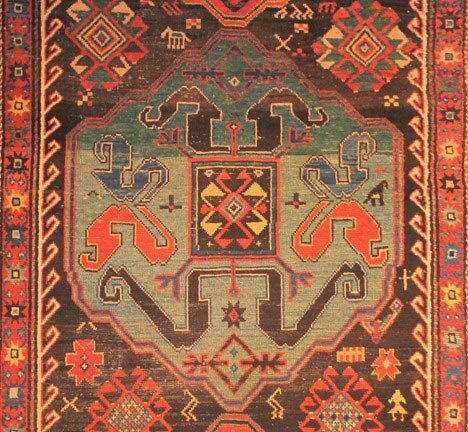A Selection of Rugs Made in Artsakh, from the Collection of the Armenian Museum of America
At the Armenian Museum of America we celebrate a shared Armenian heritage, but we also try to point out the diversity within Armenians. Regionality plays a role in how Armenians have developed based on the non-Armenian people with whom they have interacted, the flora and fauna by which they are surrounded, and the shared experiences of their neighbors. Dress, food, worship, music, and so much more are impacted by these experiences, and yet they are all Armenian.
Recently, the Armenian region of Artsakh has been attacked and the aggressors are threatening to wipe out any evidence of the Armenian culture and history. As part of our mission to preserve and promote Armenian history and culture, we are launching a series of virtual exhibitions to fight against this intended erasure, even as we are unable to welcome the public to the Museum itself.
Since Artsakh is in the most imminent danger, we have elected to highlight a facet of this particular region’s contribution to Armenian culture: the Artsakh rug.
Armenians of many regions are known for their rug making, but Artsakh stands out among the rest, with rug making going back many centuries. Armenian carpets are categorized as follows: homemade carpets for their own use, Cottage Industry rugs, and factory-made commercial rugs. The ones on “display” here, all donated to the Armenian Museum over the years, fall into one of the first two categories.
The primary patterns in Armenian rugs are:
The sun, a symbol of life
“The wheel of eternity,” most commonly four-winged and representing the four essential elements of life (earth, wind, water, fire), the four weeks of the moon cycle, and/or the four cardinal directions
The Tree of Life, which represents family, clan, or nation
A crown to represent royalty
A nest to represent the home
Bees to represent a loyal worker
A beehive to represent a well-organized and prosperous home
A dove to represent spirit
A bull, bull hide, or bull head to represent a strong and loyal assistant of a household
An octagon to represent eternity
Highly stylized zoomorphic figures such as insects
While you will find many of the above in Artsakh rugs, one can identify a rug specifically from Artsakh by the carpet weaving technique, the local wool, and the colors and patterns woven into them. Common motifs in Artsakh rugs include stylized dragons and eagles, like many Armenian rugs, but also feature other animals and even humanoid figures. In some cases Armenian rugs, including those from Artsakh, were named for the animals depicted: artsvagorg (eagle-carpet), vishapagorg (dragon-carpet), and otsagorg (serpent-carpet).
Another motif often found in Artsakh rugs is the medallion, usually featured in a repeating or alternating pattern down the center of the rug. Some may have derived from the crests of prominent clans and meliks (princes) who presided over the principalities of Artsakh until the 19th century. Some of the medallions in these and other Armenian rugs have the suffix “-berd” (fortress) in their names, which might suggest that each fortress had its own crest. These include Jraberd (Water fortress), Arevaberd (Sun fortress), and Otsaberd (Snake fortress).
Please click through to view just a few examples of the Armenian Museum’s collections of Artsakh rugs and learn more about each individual style, as curated by the Armenian Museum of America with contributions from Hratch Kozibeyokian, President of the Armenian Rugs Society.
Please hover cursor over images as you click through for caption.





